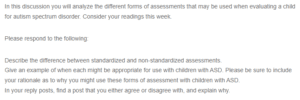Autism Spectrum Disorder Assessments
Autism spectrum disorder (ASD) is a group of disorders categorized into idiopathic disorders with unknown causes and genetic disorders with ASD features, such as Rett syndrome, tuberous sclerosis, and fragile X syndrome (Mughal et al., 2022). ASD signs and symptoms manifest in early childhood; therefore, children are evaluated for ASD as soon as possible. Assessment of ASD includes standardized and standardized assessments. Standardized assessments such as IQ tests, cognitive assessments, and genetic testing are used to compare a child’s abilities to those of other children of the same age or in the same grade. Standardized assessments use the same designed and consistent questions for every child to determine a child’s language, social and cognitive abilities. Contrariwise, non-standardized assessments of ASD, such as checklists, therapist’s notes, and interviews, are individually curated for every child to examine a child’s specific abilities, performance, and skills. A non-standardized assessment is modified to meet the individual needs of a patient. The assessment is based on a child’s clinical presentation.
Standardized assessments are formal, while non-standardized assessments are informal. Non-standardized assessments treat a child as individuals, while standardized assessments compare them to their peers (Mughal et al., 2022). Standardized assessments are universal according to guidelines, while every therapist has their own non-standardized assessment practices. Standardized assessments are appropriate for children whose abilities, growth, and development are underdeveloped for their age (Spain et al., 2022). On the other hand, non-standardized assessments are appropriate for children who cannot complete any standardized assessments. In addition, non-standardized assessments can be used as an addition to standardized assessments. Children with intellectual disability, dysmorphic features, or a family history of intellectual disability are screened using standardized tests such as genetic testing.
References
Mughal, S., Faizy, R. M., & Saadabadi, A. (2022). Autism Spectrum Disorder. StatPearls Publishing. https://www.ncbi.nlm.nih.gov/books/NBK525976/.
Spain, D., Stewart, G. R., Mason, D., Robinson, J., Capp, S. J., Gillan, N., Ensum, I., & Happé, F. (2022). Autism Diagnostic Assessments with Children, Adolescents, and Adults Prior to and During the COVID-19 Pandemic: A Cross-Sectional Survey of Professionals. Frontiers in Psychiatry, 13, 789449. https://doi.org/10.3389/fpsyt.2022.789449.
ORDER A PLAGIARISM-FREE PAPER HERE
We’ll write everything from scratch
Question
In this discussion you will analyze the different forms of assessments that may be used when evaluating a child for autism spectrum disorder. Consider your readings this week.

Autism Spectrum Disorder Assessments
Please respond to the following:
Describe the difference between standardized and non-standardized assessments.
Give an example of when each might be appropriate for use with children with ASD. Please be sure to include your rationale as to why you might use these forms of assessment with children with ASD.
In your reply posts, find a post that you either agree or disagree with, and explain why.


